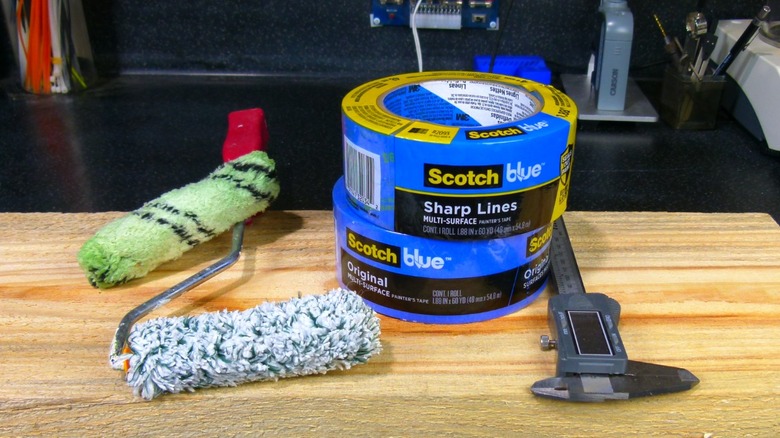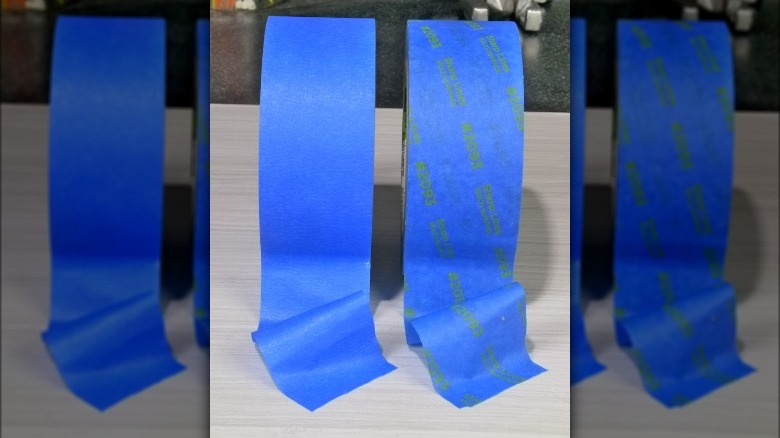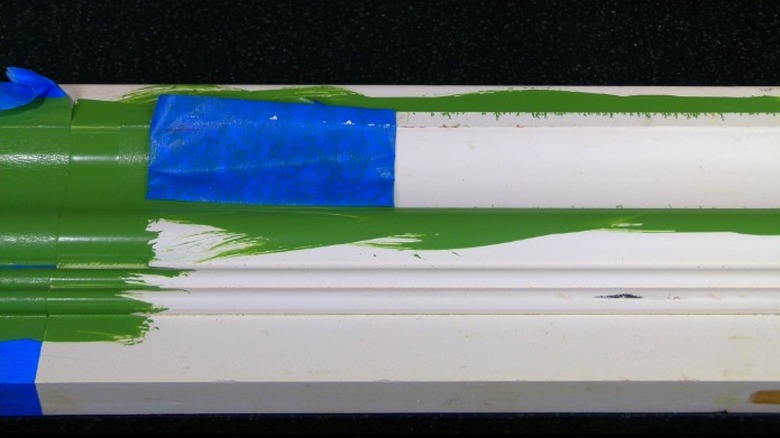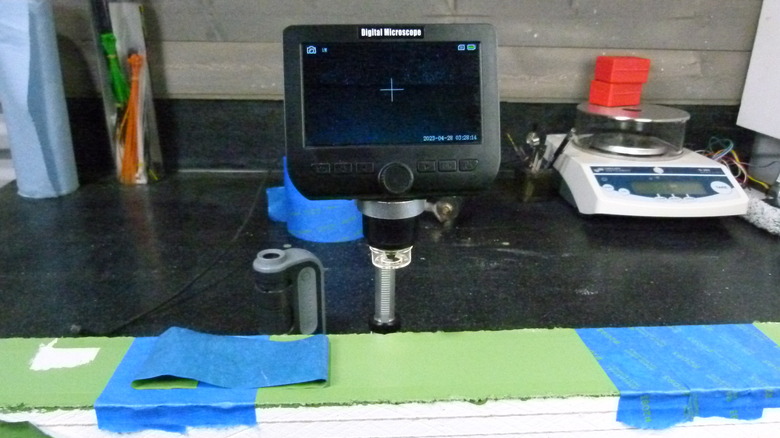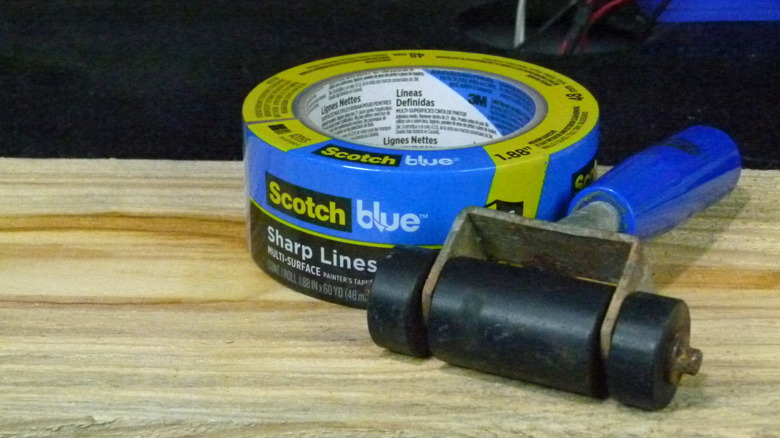We Tried Home Depot's Cheapest And Priciest Painter's Tapes (You Get What You Pay For)
We may receive a commission on purchases made from links.
Painter's tape is one of the go-to necessities in an arsenal of tools used by professionals and DIY-ers to achieve clean, crisp lines when painting surfaces in the home. It seems to be the obvious choice for precisely painted lines because it covers the part you don't want paint on. What could be simpler? Since Home Depot stores usually offer a range of products, we decided to find out if the most expensive painter's tape was worth the extra cost (about a third more than the cheapest).
There are other options, like edging tools and inexpensive masking tape. But edging tools are anything but foolproof and even tape manufacturers are quick to point out that masking tape is an inadequate solution; its beige drabness is like a beacon warning of imminent mediocrity. These measures improve your odds of achieving a clean job; a good painter's tape should all but assure it. The potential benefits are clear: Painter's tape typically promises clean paint lines, adhesion to multiple surfaces (though there are specialty tapes for some specific surfaces), and clean removal for a certain period of time (21 days for the most expensive, 14 days for the least expensive). Could there be big enough differences in performance to justify the premium price of the more expensive offering?
A tale of two ScotchBlue tapes
Both of these 3M ScotchBlue tapes are, unsurprisingly, blue, and both are labeled "multi-surface painter's tape." Painters identify them by their product numbers: #2090 for the $7.98 "Original" tape, and #2093 for the $10.68 "Sharp Lines" version. The latter claims to use "Edge-Lock Technology" to seal out paint, so that is an obvious difference to look for.
We applied 12-inch strips of 1.88-inch tape of each to satin-painted drywall, semigloss-painted trim, and unpainted underlayment. We looked for major differences in the way each protected the area underneath the tape from paint. And we took a close look to see if either is more prone to "paint dams," which are lines of thicker paint that can occur at the edge of some painter's tape, particularly thicker varieties. We also wanted to know if these tapes leave adhesive residue behind, and whether they are easy to remove or are more prone to removing the paint they're stuck to.
Testing for clean paint lines
We tested on three different finishes: unpainted plywood, semigloss paint on wood, and satin paint (with primer) on unprimed drywall. Both tapes were advertised for multi-surface application, and this trio of surfaces seemed like fairly common possibilities for most DIY paint projects. We firmly applied the tape to the flat workpieces using a vinyl seam roller, and stuck the tape to the trim piece by hand. We applied pressure as evenly as possible, and then applied paint with a roller (for the flat pieces) and a brush (for the trim), also as evenly as we could, and allowed the paint to dry for about 12 hours in fairly humid air.
Checking the results for clean lines was fairly straightforward. Since we painted over the tape strips entirely, we freed up one end of the tape with an exacto knife and pulled the tape away from the wood slowly, pulling perpendicular to the face of the workpiece. To be sure that imprecision in this process didn't affect our outcomes, we disregarded the first few inches from which the tape was removed. This was prompted by the fact that, on the painted drywall, the first few inches of the Original tape had pulled up quite a bit of the original paint ... more on that coming up.
Testing for over-adhesion, residue, and paint dams
Both tapes came away from the trim and plywood cleanly, but we had some difficulty regarding the drywall and the Original tape. While the Sharp Lines tape was removed easily, the Original tape pulled the paper facing away from the gypsum board and care had to be taken to get long enough paint edges to compare with the Sharp Lines tape. Otherwise, the only issue we had with tape pulling original paint away was on one ridge of the semigloss-painted trim piece. This was a near-90-degree corner on a trim from our stock of reusable scrap materials, and the provenance of that piece of trim is unknown. It could have been painted a few years or a few decades before. The drywall, on the other hand, was painted several months before with the same paint we used in our tests.
We checked for tape residue and paint dams using both handheld and stand-mounted digital microscopes. Simply feeling along the surface and edges for adhesive and a ridge of paint seemed equally, or perhaps even more, effective. We considered sticking tape samples to plexiglass and then examining that upon removal. But as it seems unlikely that many users would paint plexiglass in this fashion, the approach seemed unfair. If some property of the clear acrylic made the adhesive more likely to adhere, this would skew our results unacceptably.
Our verdict: a winner with no blurred lines
For the most part, the clean lines test results were clear. The Sharp Lines tape (#2093) showed almost no bleed along the edges where we applied it to the drywall and the trim. The Original paint (#2090) did an acceptable job on the drywall, but allowed a notable amount of paint under the taped edges on the trim. Both did a poor job of sealing out paint on the underlayment, which has a smooth yet porous surface. So, with the caveat that it might not do a great job on unpainted, unprimed wood, the Sharp Lines tape was the winner here, hands down.
The Sharp Lines tape did much better at leaving the paint underneath it intact and, indeed, the Original tape removed so much paint on the drywall that we would categorically eliminate it for any such use in the future. Neither tape left a noticeable amount of residue behind. This is a major consideration because tape residue tends to collect dirt and dust, and can undermine nice-looking new paint in short order. While the thinner Sharp Lines tape showed no tendency to cause paint dams, the Original tape showed marked ridges of paint build-up along its edges — certainly enough to be noticeable after the tape is removed. Overall, the ScotchBlue Sharp Lines tape was far superior to the ScotchBlue Original, and we wouldn't hesitate to spend the extra 34% for a job that looked many times better when finished.
